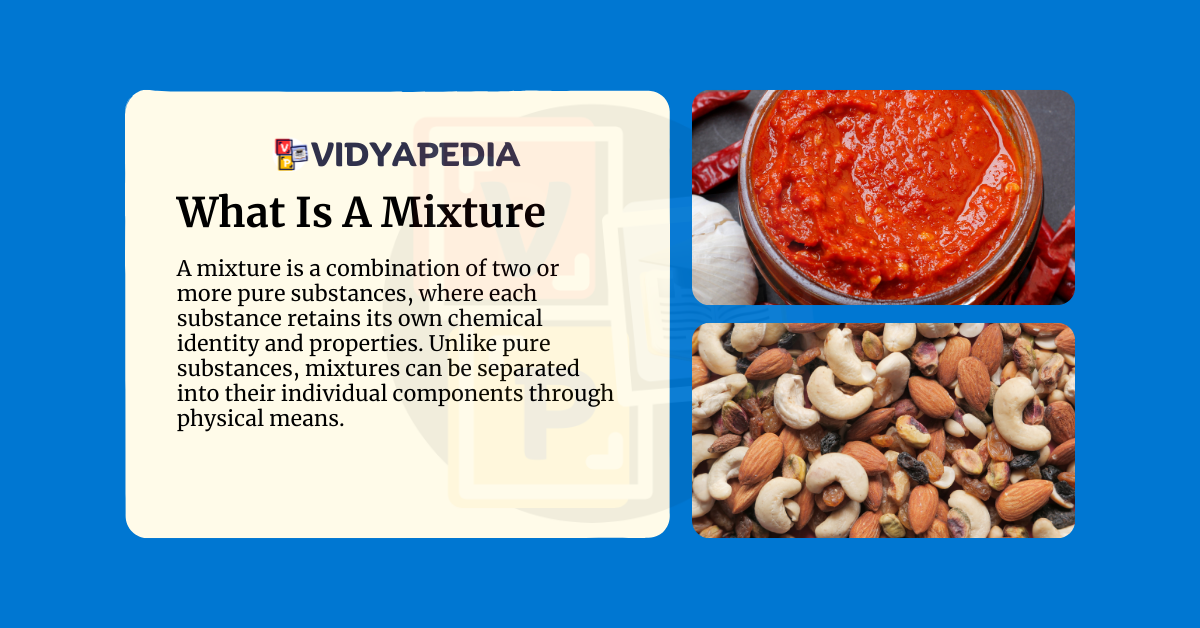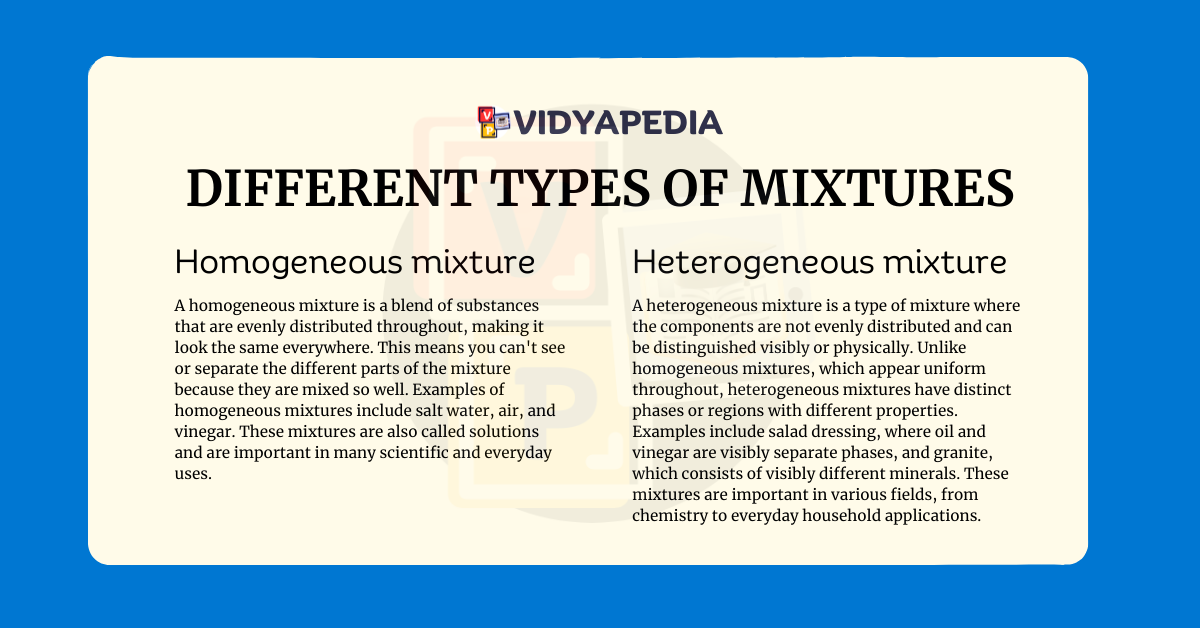Introduction
Mixtures play a crucial role in chemistry, involving the combination of two or more pure substances. Unlike compounds, which involve chemical bonds to form new substances with unique properties, mixtures maintain the characteristics of their individual components and can be separated through physical means. In this article, we will explore the different types of mixtures, their properties, and real-world examples. Dive into the fascinating world of mixtures with us and discover how they are integral to various scientific and everyday applications.
What is a mixture?

A mixture is a combination of two or more pure substances, where each substance retains its own chemical identity and properties. Unlike pure substances, mixtures can be separated into their individual components through physical means.
This enables them to preserve their original features, paving the way for a wide range of applications across different disciplines.
100 Class 9 Science Chapter 2 Question Answer On Mixture And Compound
Different types of mixtures

A homogeneous mixture is a blend of substances that are evenly distributed throughout, making it look the same everywhere. This means you can’t see or separate the different parts of the mixture because they are mixed so well. Examples of homogeneous mixtures include salt water, air, and vinegar. These mixtures are also called solutions and are important in many scientific and everyday uses.
Characteristics of Homogeneous Mixtures
Uniform Composition:
Homogeneous mixtures have a consistent appearance throughout. You can’t see or identify the separate components because they are completely blended together.
Single Phase:
These mixtures exist in only one state of matter—solid, liquid, or gas. For example, saltwater is a liquid homogeneous mixture.
Small Particle Size:
The particles in a homogeneous mixture are extremely small, at the molecular or ionic level, making them invisible to the naked eye.
No Tyndall Effect:
Because the particles are so tiny, they do not scatter light. This means you won’t see a light beam passing through the mixture, unlike in colloids or suspensions.
Homogeneous mixtures are characterized by uniformity and consistency, whereas heterogeneous mixtures exhibit diversity and variation. In this extensive analysis, we shall grasp the complexities of heterogeneous mixtures, including their qualities, examples, and scientific significance.
Examples of homogenous mixture
- Saltwater: Salt dissolved in water forms a uniform solution.
- Air: A mixture of gases like nitrogen, oxygen, carbon dioxide, and other trace gases.
- Vinegar: A solution of acetic acid in water.
- Alloys: Metals like brass (a mixture of copper and zinc) and bronze (a mixture of copper and tin) are uniform throughout.
What is a heterogeneous mixture?
A heterogeneous mixture is a type of mixture where the components are not evenly distributed and can be distinguished visibly or physically. Unlike homogeneous mixtures, which appear uniform throughout, heterogeneous mixtures have distinct phases or regions with different properties. Examples include salad dressing, where oil and vinegar are visibly separate phases, and granite, which consists of visibly different minerals. These mixtures are important in various fields, from chemistry to everyday household applications.
Characteristics of a heterogeneous mixture
Non-Uniform Composition:
- Heterogeneous mixtures have an uneven distribution of their components. You can visually distinguish the different substances within the mixture because they are not uniformly blended.
Multiple Phases:
- Unlike homogeneous mixtures, heterogeneous mixtures consist of two or more distinct phases of matter. For instance, a salad dressing containing oil and vinegar is a heterogeneous mixture with two visible phases.
Visible particle size:
- The components of heterogeneous mixtures can be large enough to be seen with the naked eye. These particles are not molecularly or ionically dispersed,, like in homogeneous mixtures.
Tyndall Effect:
- Due to the larger particle size, heterogeneous mixtures can scatter light, causing the path of light to become visible. This effect is observable in colloids and suspensions, distinguishing them from homogeneous mixtures.
List the points of differences between homogeneous and heterogeneous mixtures
Table summarizing the differences between homogeneous and heterogeneous mixtures:
| Characteristic | Homogeneous Mixtures | Heterogeneous Mixtures |
|---|---|---|
| Uniformity of Composition | Components are unevenly distributed, non-uniform appearance | Particles at the molecular or ionic level, are not visible |
| Number of Phases | Consists of one phase (solid, liquid, or gas) | Contains multiple visible phases |
| Particle Size | Particles at the molecular or ionic level, not visible | Particles vary in size, often visible |
| Visibility of Light | Does not scatter light (no Tyndall effect) | Can scatter light (Tyndall effect observable) |
| Examples | Components mix uniformly at the microscopic level | Salad dressing, granite, and muddy water |
| Mixing Uniformity | Components mix uniformly at microscopic level | Components mix unevenly, creating distinct phases |
| Physical Appearance | It appears uniform throughout | Visible separation of components |
| Phase Change Effects | Shows consistent properties throughout the mixture | Properties can vary between different phases |
| Separation Methods | Separated by physical processes like evaporation or filtration | Requires more complex separation methods due to visible phases |
| Application in Science | Common in solutions and pure substances | Often found in mixtures with varying compositions |
| Stability | More stable due to uniform distribution | Can be less stable with uneven distribution |
| Manufacturing Use | Preferred in industries for consistent product quality | Useful in creating materials with unique properties |
| Environmental Impact | Often easier to manage and recycle | Requires more careful disposal due to varied components |
| Aesthetic Considerations | Often preferred for clean, consistent appearance | Offers natural, varied aesthetic appeal |
| Mixing Efficiency | Efficient mixing due to uniform properties | Mixing can be less efficient due to varying densities and phases |
Frequently Asked Questions
What is the difference between mixture and a compound?
A mixture is when you mix two or more substances without them chemically bonding, so they keep their own properties. A compound, though, is when two or more elements bond together chemically and make something new with its own different properties.
What is an azeotropic mixture?
An azeotropic mixture is a mix of liquids that boils at the same temperature and keeps the same mix all through boiling. This happens because the mix’s vapour is the same as the liquid part at a set pressure.
What is racemic mixture?
A racemic mixture is a mix that has equal amounts of two mirror-image forms of a chiral molecule. It doesn’t show optical activity because the two forms cancel each other out.
What is principle of method of mixtures?
The principle of the method of mixtures says that the heat a body gains or loses is the same as what the surroundings gain or lose when they are at the same temperature. This is used to figure out things like specific heat capacities.
What is thermite mixture?
A thermite mixture is when you mix a metal oxide, like iron oxide, with a metal powder, like aluminium. When you light it, it reacts and produces a lot of heat. People use this for welding, cutting metal, or making fireworks.
What is the principle used in separation of mixtures?
The principle for separating mixtures depends on what the components can do physically or chemically. Different ways, like filtering, distilling, using chromatography, or separating with magnets, all use these properties, like how well they dissolve, their boiling points, or if they react to magnets.


